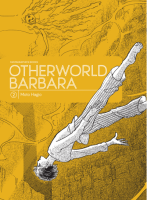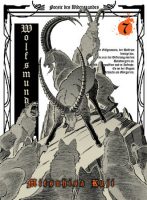My News and Reviews
Last week saw the end of one month and the beginning of another, which means the most recent monthly giveaway is currently underway at Experiments in Manga! Partially in honor of the seventh anniversary of Experiments in Manga (but largely just because I feel like it) this is a giveaway for four volumes of manga rather than just one. The winner will be announced on Wednesday, so there’s still time to enter for a chance to pick up a Variety of Vertical Comics: the first volumes of Ryo Hanada’s Devils’ Line, Chihiro Ishizuka’s Flying Witch, Riichi Ueshiba’s Mysterious Girlfriend X, and Keiichi Arawi’s Nichijou: My Ordinary Life. (I tried to make sure there was a good assortment of the types of manga currently being released by Vertical.)
Quick Takes
 Cells at Work, Volumes 2-4 by by Akane Shimizu. I enjoyed the first volume of Cells at Work tremendously, but I did wonder just how long Shimizu would be able to carry the series’ conceit without it becoming tedious. I’m still not entirely sure, but apparently for at least four volumes because I still find myself highly entertained by Cells at Work. I’ve even learned a few things about the human immune system that I either didn’t previously know or had forgotten. (It’s been a long time since I’ve taken an anatomy or physiology class.) While there are a number of recurring characters–the anthropomorphized personifications of the various types of cells and organisms found in the human body–there’s not much of an overarching story or any real character development. Cells at Work is an episodic series with each chapter’s plot generally following some variation of the same theme: the body becomes compromised and an immune response is triggered because of it. Shimizu’s approach to the subject matter is to make it as epic and frequently as comedic as possible. The artwork is great, too. Cells at Work can be spectacularly violent, but it can also be surprisingly endearing. I continue to enjoy the series a great deal and look forward seeing more of Shimizu’s mayhem.
Cells at Work, Volumes 2-4 by by Akane Shimizu. I enjoyed the first volume of Cells at Work tremendously, but I did wonder just how long Shimizu would be able to carry the series’ conceit without it becoming tedious. I’m still not entirely sure, but apparently for at least four volumes because I still find myself highly entertained by Cells at Work. I’ve even learned a few things about the human immune system that I either didn’t previously know or had forgotten. (It’s been a long time since I’ve taken an anatomy or physiology class.) While there are a number of recurring characters–the anthropomorphized personifications of the various types of cells and organisms found in the human body–there’s not much of an overarching story or any real character development. Cells at Work is an episodic series with each chapter’s plot generally following some variation of the same theme: the body becomes compromised and an immune response is triggered because of it. Shimizu’s approach to the subject matter is to make it as epic and frequently as comedic as possible. The artwork is great, too. Cells at Work can be spectacularly violent, but it can also be surprisingly endearing. I continue to enjoy the series a great deal and look forward seeing more of Shimizu’s mayhem.
 Otherworld Barbara, Omnibus 2 (equivalent to Volumes 3-4) by Moto Hagio. It’s been around a year or so since the first half of the award-winning manga series Otherworld Barbara was released in English, long enough for me to have forgotten some of the nuances of the story. Granted, I’m not sure that I was necessarily picking up on all of the nuances to begin with. I definitely enjoyed Otherworld Barbara, and am very glad that it has been released in English, but I will admit that the manga can be frustratingly confusing and difficult to follow at times. (Perhaps I should try reading the series all in one go.) Otherworld Barbara is a very strange series and there’s a lot going on in it. Arguably a bit too much. Among many other things genetic experimentation, the search for immortality, Martian wars, dreams which impact reality and influence the future, existential crises, psychic confrontations, disastrous relationships, and precarious family dynamics all contribute to the narrative’s chaos and occasional lack of cohesiveness. In the end everything does successfully come together in a way that largely makes sense, but it does take some seemingly convenient plot twists for it all to happen. Even so, I found Otherworld Barbara to be immensely intriguing.
Otherworld Barbara, Omnibus 2 (equivalent to Volumes 3-4) by Moto Hagio. It’s been around a year or so since the first half of the award-winning manga series Otherworld Barbara was released in English, long enough for me to have forgotten some of the nuances of the story. Granted, I’m not sure that I was necessarily picking up on all of the nuances to begin with. I definitely enjoyed Otherworld Barbara, and am very glad that it has been released in English, but I will admit that the manga can be frustratingly confusing and difficult to follow at times. (Perhaps I should try reading the series all in one go.) Otherworld Barbara is a very strange series and there’s a lot going on in it. Arguably a bit too much. Among many other things genetic experimentation, the search for immortality, Martian wars, dreams which impact reality and influence the future, existential crises, psychic confrontations, disastrous relationships, and precarious family dynamics all contribute to the narrative’s chaos and occasional lack of cohesiveness. In the end everything does successfully come together in a way that largely makes sense, but it does take some seemingly convenient plot twists for it all to happen. Even so, I found Otherworld Barbara to be immensely intriguing.
 Wolfsmund, Volumes 7-8 by Mitsuhisa Kuji. While it seemed like Wolfsmund had reached a natural ending point in the sixth volume, apparently Kuji had always intended the manga to be longer than that; with eight volumes, Kuji was able to reach the series’ conclusion as it was originally envisioned. Wolfsmund is an incredibly violent and frequently gruesome manga based on the historical conflict between the Swiss Confederacy and the Habspurg-led Austrian occupying forces in the early fourteenth century. The series culminates with the Battle of Morgarten, a pivotal moment in the history of Switzerland. That battle and the various skirmishes that lead up to it are brutal and legitimately gut-wrenching. Kuji does not at all shy away from showing the blood and gore associated with pre-modern warfare. The atmosphere that Kuji creates is exceptionally dark, heavy, and oppressive, the few moments of hope overshadowed by desperation and despair. However, the members of the Confederacy’s peasant army show astounding devotion to their cause even when faced with overwhelming odds. I can’t say that I was ever emotionally invested in Wolfsmund, but it was a gripping retelling.
Wolfsmund, Volumes 7-8 by Mitsuhisa Kuji. While it seemed like Wolfsmund had reached a natural ending point in the sixth volume, apparently Kuji had always intended the manga to be longer than that; with eight volumes, Kuji was able to reach the series’ conclusion as it was originally envisioned. Wolfsmund is an incredibly violent and frequently gruesome manga based on the historical conflict between the Swiss Confederacy and the Habspurg-led Austrian occupying forces in the early fourteenth century. The series culminates with the Battle of Morgarten, a pivotal moment in the history of Switzerland. That battle and the various skirmishes that lead up to it are brutal and legitimately gut-wrenching. Kuji does not at all shy away from showing the blood and gore associated with pre-modern warfare. The atmosphere that Kuji creates is exceptionally dark, heavy, and oppressive, the few moments of hope overshadowed by desperation and despair. However, the members of the Confederacy’s peasant army show astounding devotion to their cause even when faced with overwhelming odds. I can’t say that I was ever emotionally invested in Wolfsmund, but it was a gripping retelling.




